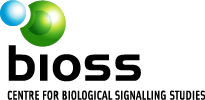BIOSS-A

Membranes and protein–lipid interactions in signalling
BIOSS-B

Oncogenic signalling
BIOSS-C

Re-building & biotechnology
BIOSS

From Analysis
to Synthesis
Dr. Gerhard Mittler

Dr. Gerhard Mittler
Max-Planck-Institute of Immunbiology and Epigenetics Freiburg
Our research facility is specialized in functional proteomics, which is concerned with correlating physiological changes at the cellular level with alterations in protein composition and protein modifications as a major discovery and hypothesis generating tool. To pursue this we employ metabolic labeling using stable isotopes (SILAC) in order to not only achieve a comprehensive qualitative but also a quantitative description of subproteomes using state-of-the-art nanoLC-MS technology. We have been successfully studying rather complex proteomes, like subcellular structures (e.g. nuclear matrix) and interactomes (Cdk9 interactome). In addition we are especially interested in the characterization of macromolecular complexes (DNA/RNA-protein and protein-protein complexes), which can be isolated by means of classical biochemical purification methodologies.
Biologically, we have a long term interest in studying metazoan gene regulation in the context of transcription factors and epigenetics (e.g. protein methylation) [1, 2]. To further our understanding of the gene regulatory code we have pioneered a quantitative proteomics approach termed SILAC DNA-protein interaction screening [1] that is complementary to the classical chromatin immunoprecipitation (ChIP) method since our technology reveals proteins that are able to specifically interact with any cis-regulatory element of interest. Studying a novel evolutionary highly conserved core promoter-associated cis-element termed M4 [3], we could recently demonstrate that our methodology has the capacity to uncover novel biologically important and physiologically relevant TF DNA interactions.
We are now in the process of streamlining the technology for higher sensitivity, stringency and efficiency. We have also started to transfer the technology to living cells to reach our final goal of establishing a bona fide ‘reversed ChIP’ [4] approach.
[1] Mittler, G. et al., 2009. Genome Res. 19, 284-293
[2] Ong, S.E. et al., 2004, Nat. Methods 1, 119-126
[3] Xie, X. et al., 2005, Nature 434, 338-345
[4] Rusk, N., 2009. Nat. Methods 6, 187
10 selected publications:
- Complete loss of H3K9 methylation dissolves mouse heterochromatin organization.
Montavon T, Shukeir N, Erikson G, Engist B, Onishi-Seebacher M, Ryan D, Musa Y, Mittler G, Meyer AG, Genoud C, Jenuwein T.
Nat Commun. 2021 Jul 16;12(1):4359. - A Prion-like Domain in Transcription Factor EBF1 Promotes Phase Separation and Enables B Cell Programming of Progenitor Chromatin.
Wang Y, Zolotarev N, Yang CY, Rambold A, Mittler G, Grosschedl R.
Immunity. 2020 Dec 15;53(6):1151-1167 - ELAV and FNE Determine Neuronal Transcript Signatures through EXon-Activated Rescue.
Carrasco J, Rauer M, Hummel B, Grzejda D, Alfonso-Gonzalez C, Lee Y, Wang Q, Puchalska M, Mittler G, Hilgers V.
Mol Cell. 2020 Oct 1;80(1):156-163.e6 - CAPRI enables comparison of evolutionarily conserved RNA interacting regions.
Panhale A, Richter FM, Ramírez F, Shvedunova M, Manke T, Mittler G, Akhtar A.
Nat Commun. 2019 Jun 18;10(1):2682. - Comprehensive Proteomic Investigation of Ebf1 Heterozygosity in Pro-B Lymphocytes Utilizing Data Independent Acquisition.
Musa YR, Boller S, Puchalska M, Grosschedl R, Mittler G.
J Proteome Res. 2018 Jan 5;17(1):76-85. - Histone propionylation is a mark of active chromatin.
Kebede AF, Nieborak A, Shahidian LZ, Le Gras S, Richter F, Gómez DA, Baltissen MP, Meszaros G, Magliarelli HF, Taudt A, Margueron R, Colomé-Tatché M, Ricci R, Daujat S, Vermeulen M, Mittler G, Schneider R.
Nat Struct Mol Biol. 2017 Dec;24(12):1048-1056 - Biochemical and cellular characterization of transcription factors binding to the hyperconserved core promoter-associated M4 motif.
Trung NT, Kremmer E, Mittler G.
BMC Genomics. 2016 Aug 30;17(1):693 - The quantitative nuclear matrix proteome as a biochemical snapshot of nuclear organization.
Engelke R, Riede J, Hegermann J, Wuerch A, Eimer S, Dengjel J, Mittler G.
J Proteome Res. 2014 Sep 5;13(9):3940-56 - A SILAC-based DNA-protein interaction screen that identifies candidate binding proteins to functional DNA elements.
Mittler G, Butter F, Mann M (2009).
Genome Res. 19, 284-293 - Identifying and quantifying in vivo methylation sites by heavy methyl SILAC.
Ong SE, Mittler G*, Mann M* (2004).
Nature Methods 1, 119-126 (* shared corresponding authors).
